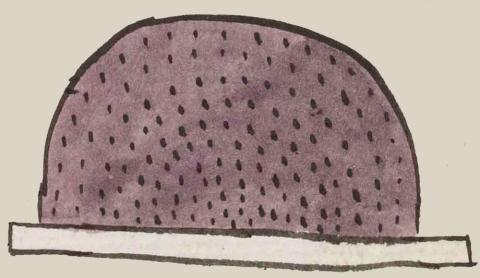Tlatelolco (Mdz19r)
This glyph for Tlatelolco consists primarily of the element tlatelli [also spelled tlatilli), a hillock or large mound. The mound, painted purple and dotted as though made of rock or sand, has a white rectangular base.
Stephanie Wood
This glyph captures the essence of the place name by showing a hillock or mound of earth (tlatelli). The locative suffix -co is not shown, unless it is imbedded in the base at the bottom of the mound. Given the presence of a base, this mound could be a visual reference to what we might call a pyramid, a constructed mound, which would have had a religious use and significance. The internal element, -ol- has not yet been analyzed; if it is not represented visually, we may need to reclassify this glyph as a compound. The presence of the sand (xalli), shown here as dotted, which makes up the hillock, may substantiate Rémi Siméon's suggestion that Xaltilolco was the original name for the city. See: Tetlacuilolli. Interestingly, the glyph for Tlatelolco in the Codex Telleriano-Rememsis, folio 33 verso, takes the shape of a tepetl), but it is also colored purple. The texturing here, in lieu of dots for sand, are "u" shapes that are reminiscent of the texturing of tlal(li). See: Gordon Whittaker, Deciphering Aztec Hieroglyphs (2021), 25, figure 1.8.b.
Stephanie Wood
Stephanie Wood
c. 1541, or by 1553 at the latest
Stephanie Wood
hillocks, mounds, mogotes, cerros, pyramids, montículos, pirámides, nombres de lugares

tlatel(li), large mound, https://nahuatl.wired-humanities.org/content/tlatelli
tlatil(li), large mound, https://nahuatl.wired-humanities.org/content/tlatilli
-co (locative suffix), https://nahuatl.wired-humanities.org/content/co
Codex Mendoza, folio 19 recto, https://digital.bodleian.ox.ac.uk/objects/2fea788e-2aa2-4f08-b6d9-648c00..., image 48 of 188.
The Bodleian Libraries, University of Oxford, hold the original manuscript, the MS. Arch. Selden. A. 1. This image is published here under the UK Creative Commons, “Attribution-NonCommercial-ShareAlike 3.0 License” (CC-BY-NC-SA 3.0).

